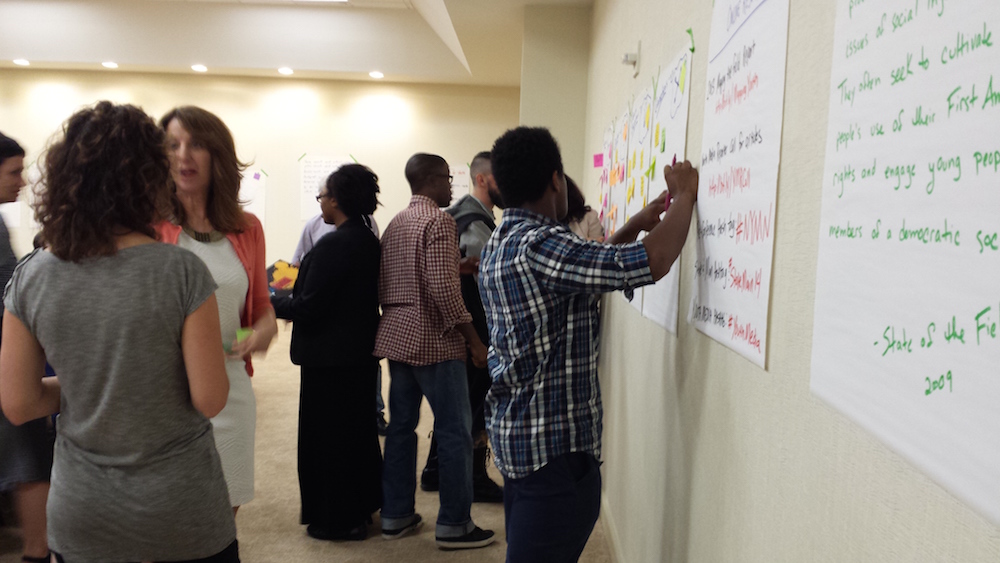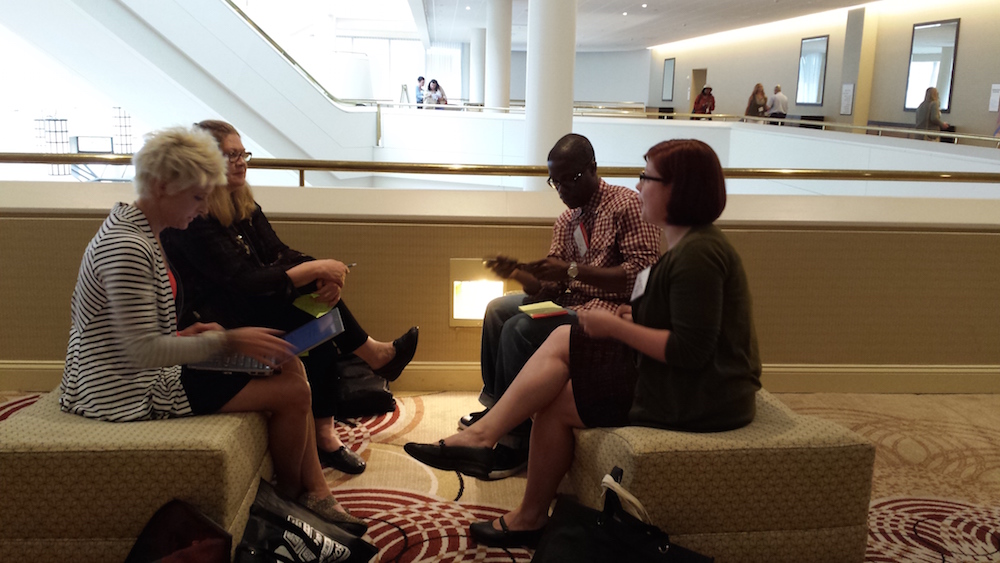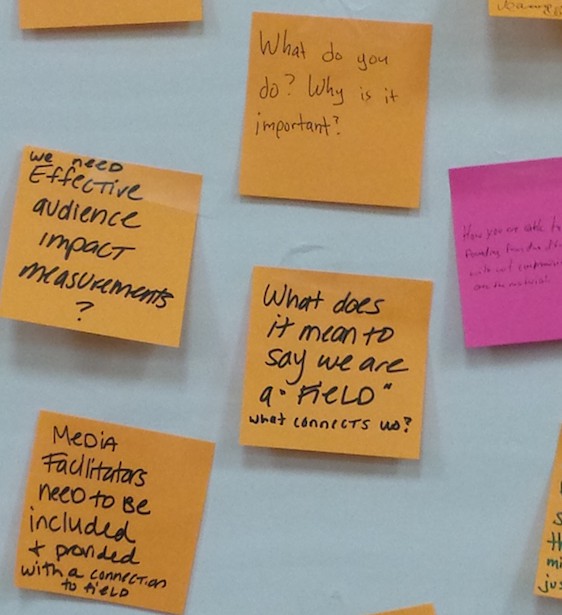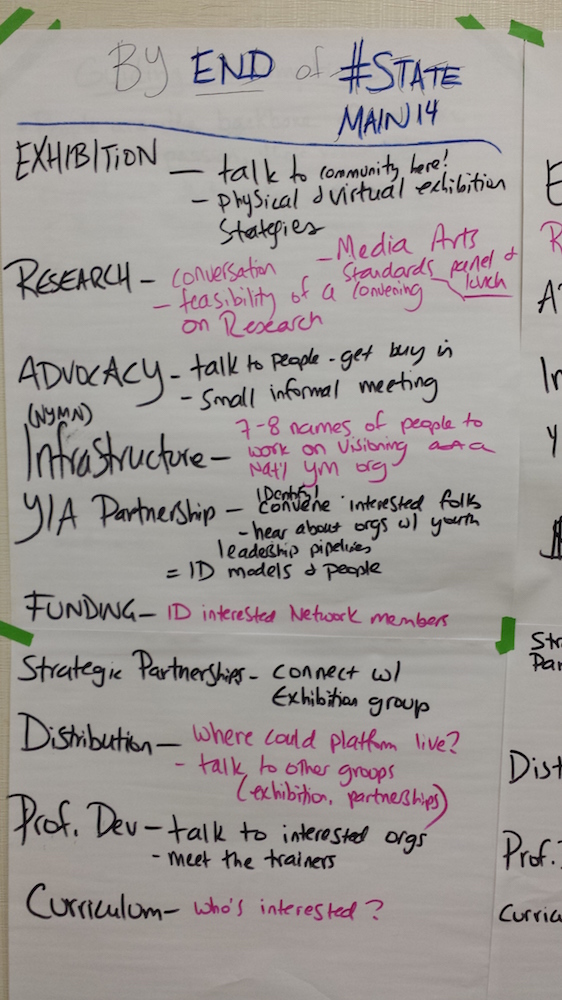In August 2014, over forty youth media practitioners, leaders and stakeholders gathered at the National Alliance for Media Arts & Culture (NAMAC)/Alliance for Community Media (ACM) Joint Conference in Philadelphia. The premise of this gathering –sponsored by Youth Media Reporter – was that there is now, as there has always been, a need for network building, resource sharing, and the nurturing of collective power around challenges and opportunities in youth media practices across the country.

Attendees represented manifold perspectives; they were teaching artists, youth media alumni, local and national funders, public school educators, nonprofit leaders, academics, researchers, activists and more. Guided by the facilitation of Jason Wyman, participants were asked to identify needs and visualize multi-stakeholder solutions pertaining to, for example, exhibition and distribution strategies, the infrastructure of a National Youth Media Network, youth and adult partnerships, funding, and other such critical matters. A full list of areas of focus and proposed visions can be found here: https://titanpad.com/youthmediameetings
The discussions at this convening were richly textured and rife with possibility; each idea warrants its own in-depth engagement. If, however, we were to distill the five-hour, intensive into a central question, it might be: how do we organize to optimize the power and potential of youth media work?
In that regard, it may be helpful to consider the national conversations emerging within multidisciplinary youth arts organizations. Last March over 200 representatives from community based organizations across the country that serve young people in the arts, humanities, and sciences gathered in Boston to finalize a policy agenda and develop key strategies to advance the work of what is now being termed the Creative Youth Development field in an effort to support the creative and intellectual development of the young people in our communities. The Creative Youth Development Summit was informed by research conducted throughout the fall of 2013 by Lauren Stevenson and Junction Box Consulting in Oakland, California.
The Summit was hosted by the Massachusetts Cultural Council (MCC) and presented in partnership with the President’s Committee on Arts and Humanities (PCAH) and the National Guild for Community Arts Education (NGCAE) as a celebration of MCC’s 20th anniversary of Youth Reach, its grant program that supports out-of-school-time programs that help young people develop creatively and intellectually and in turn prepares them for future success. More information about the Summit can be found online at: http://creativeyouthsummit.org/index.html.

Since the March 2014 Summit and the creation of the National Policy Agenda for Creative Youth Development, key stakeholders have gathered to further discuss the work and continue to move the dial forward. One such gathering was the National Guild for Community Arts Education’s annual conference in Los Angeles in November. A pre-conference and several round table sessions were held to discuss this work and what should be done to continue to advance the agenda. In December, the CYD partners once again met to discuss how this work is going to continue and who is going to take the lead. The results of that meeting have yet to be released.
 Regardless of who or how this work is going to get done, the CYD movement is a growing national effort to elevate very similar work that so many of us in youth media have been doing for years; yet, our two groups are largely disconnected. The CYD policy agenda is rooted in strategies around youth leadership, cross-sector collaboration, sustainable funding models, and communicating impact on a broad scale – much of the same strategies that youth media organizations have been employing for years. While there is no doubt overlap in the numbers, if you combine 200 organizations with the nearly 100 within youth media, we are significantly impacting the lives of hundreds of thousands of young people across the country!
Regardless of who or how this work is going to get done, the CYD movement is a growing national effort to elevate very similar work that so many of us in youth media have been doing for years; yet, our two groups are largely disconnected. The CYD policy agenda is rooted in strategies around youth leadership, cross-sector collaboration, sustainable funding models, and communicating impact on a broad scale – much of the same strategies that youth media organizations have been employing for years. While there is no doubt overlap in the numbers, if you combine 200 organizations with the nearly 100 within youth media, we are significantly impacting the lives of hundreds of thousands of young people across the country!
So what now? Over the past year, NAMAC has had a leadership change and their new Executive Director Wendy Levy has been working tirelessly to reshape, rethink, and retool the organization to meet the needs of a growing community of independent media artists and organizations across the country, including those within the youth media field. NAMAC is now ready to help pick up the conversation where it left off after the conference in 2014. NAMAC, led by Wendy Levy, facilitated a conversation amongst the field on March 9, 2015, including over 40 youth media leaders. This 90-minute virtual roundtable focused on strategies for convening, growing and sustaining youth media organizations, along with the best ways to collaborate for collective impact in our communities. All are welcome to view the roundtable conversation:
Next steps would also need to include or integrate intermediary organizations with whom the work of youth media intersects: YMR, NAMAC, ACM, the NGCAE, NAMLE, and/or others. As a network, we can identify priorities – as we did in the NAMAC pre-conference – and align with strategic partners to communicate, collaborate and leverage each other’s work.
As we saw in the aftermath of the NAMAC pre-conference, an agenda-setting and implementation effort requires capacity. While support from YMR and NAMAC were essential to the National Youth Media Network’s administration over the last two years, we have largely operated on minimal resources and immense volunteer energy. In this context, we proved our power in numbers: we were in consistent and enthusiastic communication; we hosted a series of online conversations (guided by priorities expressed within the Network); we organized several conference presentations; we hosted a national youth media contest in partnership with high-profile partners like the DoGooder Awards; and we grew the Network from 30 youth media practitioners and organizations to well over 100.
We’ve seen through examples such as the Open Society Youth Media Initiative, what sustained operational support can do for cohering the field. We have so far effectively and repeatedly demonstrated our commitment to work collectively with minimal support to elevate the youth voice and perspective on a national level and to help nourish and support this growing field. In order to keep growing and to implement the visionary and mutually reinforcing ideas that were discussed at the NAMAC Conference or that are discussed in this new issue of YMR, we need to work together to ensure that this grassroots effort to connect, share and learn with and through one another, has a solid foundation and steady administrative support going forward.


